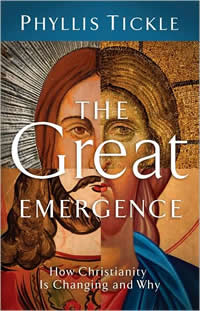Book Notes
 Phyllis Tickle, The Great Emergence; How Christianity is Changing and Why (Grand Rapids: Baker Book House, 2008), 172pp.
Phyllis Tickle, The Great Emergence; How Christianity is Changing and Why (Grand Rapids: Baker Book House, 2008), 172pp.
For the last twenty years, Phyllis Tickle has been one of the more notable and quotable commentators on the changing landscape of American religion. In 1992 she became the founding editor of the Religion Department at Publishers Weekly. She has written more than two dozen books and given interviews with major media outlets like Time magazine, CNN, and PBS. Today she is a senior fellow of Cathedral College at the National Cathedral in Washington.
Tickle explores three questions in this book. What is the Great Emergence? How did it come to be? And where is it going? She limits herself to Christianity in North America, but her overall trajectory is a prime example of the pleasures and pitfalls of Grand Theory writing. According to Tickle, there's a "recurrent pattern" in which every 500 years Christianity sheds "the incrustations of an overly established" institution and reinvents itself. She sees a similar phenomenon in Islam and Judaism. Pope Gregory the Great (b. 540) was the first disrupter and preserver in her scheme, saving civilization through promoting monasticism. Then came the Great Schism of 1054 when Roman Catholicism of the Latin West and Eastern Orthodoxy of the Greek East divided. Then, right on schedule, came the Protestant Reformation in 1517.
Closer to our own day, Tickle samples a handful of the "three-dozen" signs of the times that indicate another major disruption and reinvention of the faith — Darwin, Freud, Jung, Marx, and Einstein, science, the radio, the automobile, the rise of pentecostalism, and even a group like Alcoholics Anonymous. Tickle acknowledges that such chronological markers and sweeping generalizations can be artificial and even superficial (cf. 95, 111). Each person, movement or invention gets only a paragraph or so of commentary; the Renaissance and the Enlightenment, for example, are barely mentioned at all.
In the last third of her book Tickle explains how and why older categories of describing American Christianity are now passe. If and when the current 500-year Great Emergence matures, Tickle estimates that it will include about 60% of North American believers. Forget about "main line" denominations or categories like "liberal" and "conservative." Rather, begin with four major trends — Liturgicals, Renewalists, Social Justice Christians, and Conservatives — and then imagine endless permutations and hybrids that mix, match, and cross-pollinate.
Tickle's historiography is the sort that drives scholarly experts crazy, but there's no question about the phenomenon she describes. Whether it's as long-lasting or disruptive as 1054 or 1517 remains to be seen. The book by Brian McLaren with its suggestive sub-title is a good example of what she describes: A Generous Orthodoxy: Why I am a missional + evangelical + post/protestant + liberal/conservative + mystical/poetic + biblical + charismatic/contemplative + fundamentalist/calvinist + anabaptist/anglican + methodist + catholic + green + incarnational + depressed-yet-hopeful + emergent + unfinished CHRISTIAN (2004). The best book about all things "emergent" by one of its adherents is Tony Jones, The New Christians; Dispatches from the Emergent Frontier (2008).


